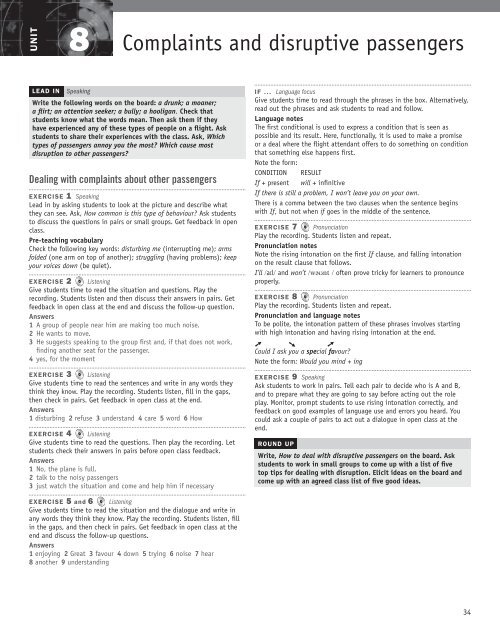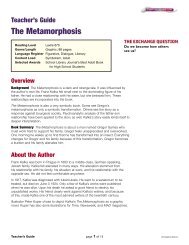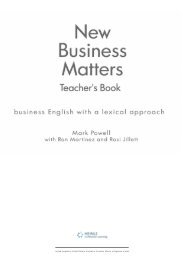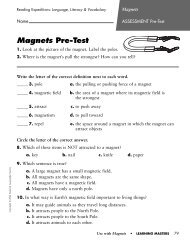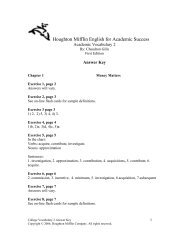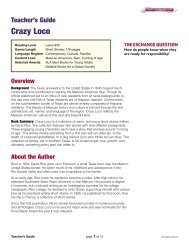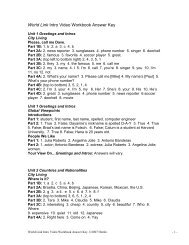English for Cabin Crew Trainer's Guide - Heinle
English for Cabin Crew Trainer's Guide - Heinle
English for Cabin Crew Trainer's Guide - Heinle
You also want an ePaper? Increase the reach of your titles
YUMPU automatically turns print PDFs into web optimized ePapers that Google loves.
UNIT<br />
LEAD IN Speaking<br />
8 Complaints and disruptive passengers<br />
Write the following words on the board: a drunk; a moaner;<br />
a fl irt; an attention seeker; a bully; a hooligan. Check that<br />
students know what the words mean. Then ask them if they<br />
have experienced any of these types of people on a fl ight. Ask<br />
students to share their experiences with the class. Ask, Which<br />
types of passengers annoy you the most? Which cause most<br />
disruption to other passengers?<br />
Dealing with complaints about other passengers<br />
EXERCISE 1 Speaking<br />
Lead in by asking students to look at the picture and describe what<br />
they can see. Ask, How common is this type of behaviour? Ask students<br />
to discuss the questions in pairs or small groups. Get feedback in open<br />
class.<br />
Pre-teaching vocabulary<br />
Check the following key words: disturbing me (interrupting me); arms<br />
folded (one arm on top of another); struggling (having problems); keep<br />
your voices down (be quiet).<br />
EXERCISE 2 Listening<br />
Give students time to read the situation and questions. Play the<br />
recording. Students listen and then discuss their answers in pairs. Get<br />
feedback in open class at the end and discuss the follow-up question.<br />
Answers<br />
1 A group of people near him are making too much noise.<br />
2 He wants to move.<br />
3 He suggests speaking to the group fi rst and, if that does not work,<br />
fi nding another seat <strong>for</strong> the passenger.<br />
4 yes, <strong>for</strong> the moment<br />
EXERCISE 3 Listening<br />
Give students time to read the sentences and write in any words they<br />
think they know. Play the recording. Students listen, fi ll in the gaps,<br />
then check in pairs. Get feedback in open class at the end.<br />
Answers<br />
1 disturbing 2 refuse 3 understand 4 care 5 word 6 How<br />
EXERCISE 4 Listening<br />
Give students time to read the questions. Then play the recording. Let<br />
students check their answers in pairs be<strong>for</strong>e open class feedback.<br />
Answers<br />
1 No, the plane is full.<br />
2 talk to the noisy passengers<br />
3 just watch the situation and come and help him if necessary<br />
EXERCISE 5 and 6 Listening<br />
Give students time to read the situation and the dialogue and write in<br />
any words they think they know. Play the recording. Students listen, fi ll<br />
in the gaps, and then check in pairs. Get feedback in open class at the<br />
end and discuss the follow-up questions.<br />
Answers<br />
1 enjoying 2 Great 3 favour 4 down 5 trying 6 noise 7 hear<br />
8 another 9 understanding<br />
IF ... Language focus<br />
Give students time to read through the phrases in the box. Alternatively,<br />
read out the phrases and ask students to read and follow.<br />
Language notes<br />
The fi rst conditional is used to express a condition that is seen as<br />
possible and its result. Here, functionally, it is used to make a promise<br />
or a deal where the fl ight attendant offers to do something on condition<br />
that something else happens fi rst.<br />
Note the <strong>for</strong>m:<br />
CONDITION RESULT<br />
If + present will + infi nitive<br />
If there is still a problem, I won’t leave you on your own.<br />
There is a comma between the two clauses when the sentence begins<br />
with If, but not when if goes in the middle of the sentence.<br />
EXERCISE 7 Pronunciation<br />
Play the recording. Students listen and repeat.<br />
Pronunciation notes<br />
Note the rising intonation on the fi rst If clause, and falling intonation<br />
on the result clause that follows.<br />
I’ll /aIl/ and won’t /w@Unt / often prove tricky <strong>for</strong> learners to pronounce<br />
properly.<br />
EXERCISE 8 Pronunciation<br />
Play the recording. Students listen and repeat.<br />
Pronunciation and language notes<br />
To be polite, the intonation pattern of these phrases involves starting<br />
with high intonation and having rising intonation at the end.<br />
➚ ➘ ➚<br />
Could I ask you a special favour?<br />
Note the <strong>for</strong>m: Would you mind + ing<br />
EXERCISE 9 Speaking<br />
Ask students to work in pairs. Tell each pair to decide who is A and B,<br />
and to prepare what they are going to say be<strong>for</strong>e acting out the role<br />
play. Monitor, prompt students to use rising intonation correctly, and<br />
feedback on good examples of language use and errors you heard. You<br />
could ask a couple of pairs to act out a dialogue in open class at the<br />
end.<br />
ROUND UP<br />
Write, How to deal with disruptive passengers on the board. Ask<br />
students to work in small groups to come up with a list of fi ve<br />
top tips <strong>for</strong> dealing with disruption. Elicit ideas on the board and<br />
come up with an agreed class list of fi ve good ideas.<br />
34


